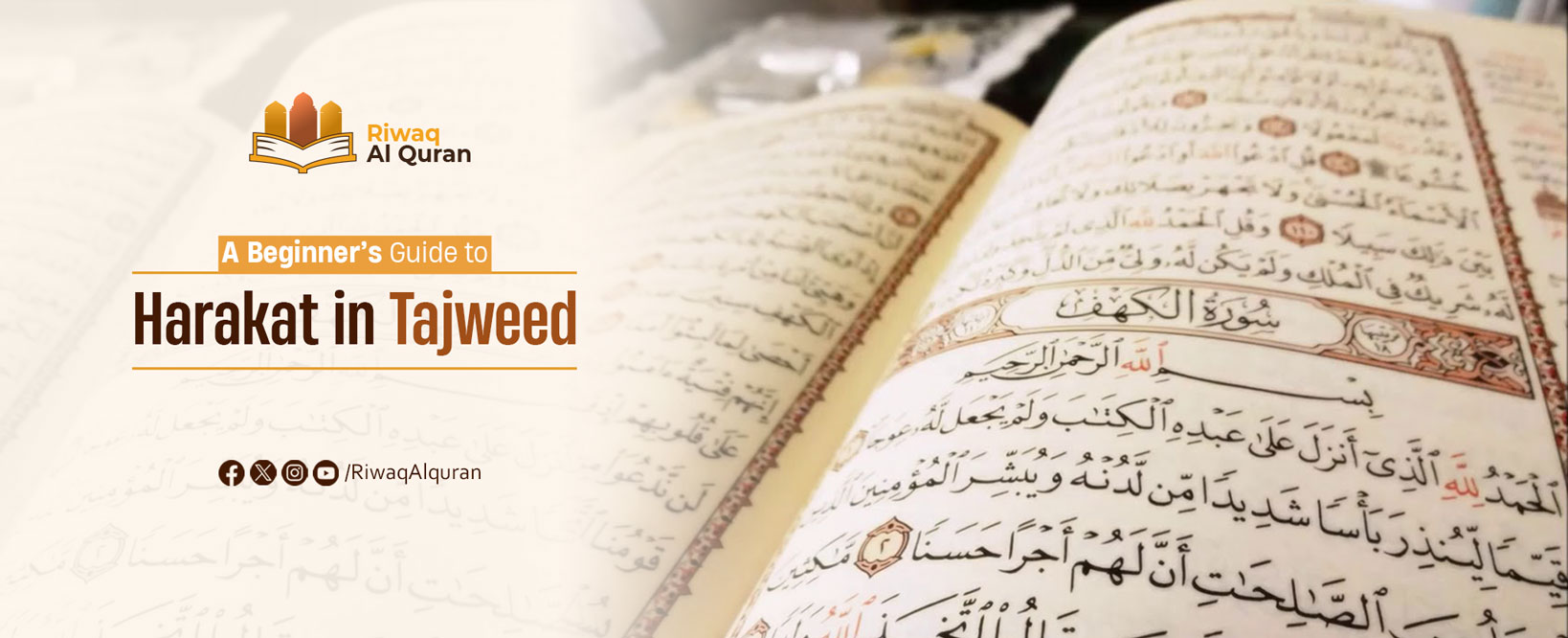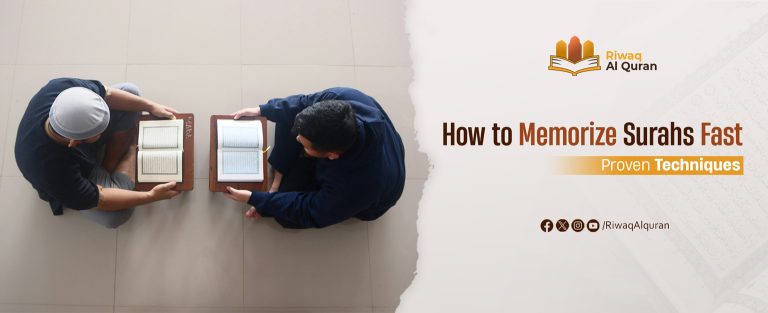In Arabic, Harakat (حركات) is a vital concept with tremendous significance. There are only 3 main Harakat in Arabic. Although they are few in number, they are of huge importance. What are they and how important they are will be elaborated, in some detail, in this article. We will tackle the definition of Harakat, what is Harakat in Tajweed, and the types of Harakat.
We will also discuss how many Harakat are there in Arabic, and the difference between Harakat and Tashkeel. We will also give some Harakat examples from the Quran. Also, we will examine Arabic Harakat rules, the benefits of learning Arabic Harakat, and how to learn Arabic Harakat. Finally, we will talk about common mistakes made in applying Harakat and how to avoid them.
Table of Contents
The Meaning Of Harakah In Tajweed
Harakat in Tajweed are essential for accurate pronunciation and recitation of the Quran. It is mainly about the timing of one Harakah when reciting the Quran. Let’s examine this point in some detail:
Harakat As A Length Of Pronouncing A Letter: This refers to how many Harakat are there for each letter. One Haraka is equal to one finger count. Let’s examine this:
1- Constants:
Usually, a constant takes only 1 Haraka.
Example:
“قُلْ هُوَ ٱللَّهُ أَحَدٌ”
Each of the letters of the word “أحد” takes only 1 Haraka.
2- Normal Madd:
The normal Madd (extension) of the 3 Arabic letters (أ و ي) is 2 Harakat, each. So an Arabic person with perfect pronunciation will normally give these 2 Harakat when reading any of أ و ي letters.
Example:
“وَٱلتِّينِ وَٱلزَّيْتُونِ ١ وَطُورِ سِينِينَ ٢ وَهَـٰذَا ٱلْبَلَدِ ٱلْأَمِينِ ٣ لَقَدْ خَلَقْنَا ٱلْإِنسَـٰنَ فِىٓ أَحْسَنِ تَقْوِيمٍۢ”
In these 4 verses, all و and ي letters have 2 Harakat. So if the word “وَٱلتِّينِ” is given only 1 Haraka, the recitation (Tajweed) of this word will be incorrect.
3 – Other Kinds Of Madd:
There are other types of Madd in the Quran that have to be 4-6 Harakat. Some of them are mandatory and some are optional.
Example:
“وَلَا ٱلضَّآلِّينَ”
In this part of the verse, the “آ” sound in the word ٱلضَّآلِّينَ needs to have 4 Harakat, while the “يـ” sound in the same word should have 6 Harakat so that the recitation of this word is correct.
To sum up, Harakat, in this sense, is used to organize how long a letter will be pronounced so that the recitation will be correct.


What Is Harakat In Arabic?
Harakat (الحركات) are the marks placed above or below Arabic letters to indicate the correct pronunciation of letters. According to this definition, Arabic letters are divided into 2 main categories based on whether they have Haraka or not. Let’s examine them:
1- Mutahrik (متحرك) (A Letter With A Haraka):
We will see below, in some detail, that there are 3 main Harakat in Arabic: Fatha (َ), Damma (ُ) and Kasra (ِ). On one hand, a Mutahrik letter is one that has one of these Harakat. When pronouncing this kind of letter, the lips of the speaker move in a certain way. Please see the image below:

Example:
“قُلْ هُوَ ٱللَّهُ أَحَدٌ”
The ق letter in “قُلْ” is marked with a Damma (ُ), so it is a Mutahrik letter.
2- Sakin (A Letter Without Any Haraka):
On the other hand, a Sakin letter is a letter that has no Harakat. It is denoted by a small حـ above the letter or with nothing placed above or under the letter.
Example 1:
“قُلْ هُوَ ٱللَّهُ أَحَدٌ”
In the same word “قُلْ”, the letter لْ is marked with a small حـ, so it is a Sakin letter.
Example 2:
“مِن شَرِّ مَا خَلَقَ”
In the word “مِن”, the letter “ن” has nothing above or below it, so this letter here is Sakin.
How Many Harakat Are There In Arabic?
Now it is time to examine how many Harakat are there in Arabic. As we have seen in the previous paragraph, there are 3 main Harakat in Arabic. These are Fatha [الفتحة] (َ), Damma [الضمة] (ُ) and Kasra [الكسرة] (ِ). These three Harakat are the foundation of Arabic pronunciation and are essential for understanding and speaking Arabic correctly.
1- Fatha (َ):
It represents the short “a” sound [like the “a” sound at the beginning of the word “up”]. It is done by opening the mouth horizontally and keeping the tongue in the resting position.
Example:
كَتب
The first letter of this word is pronounced as “ka”, as it has a Fatha.
Placement of Haraka: Above the letter.
2. Damma (ُ):
It represents the short “u” sound [like the “u” sound at the beginning of the word “over”]. Both lips should be rounded when pronouncing the Damma, otherwise, the sound is incorrect or incomplete.
Example:
كُتب
The first letter of this word is pronounced as “ku”, as it has a Damma.
Placement of Haraka: Above the letter.
3. Kasra (ِ):
It represents the short “i” sound [like the “i” sound in the middle of the word “keeper”]. The lower jaw is lowered and the tongue is lifted.
Example:
كِتاب
The first letter of this word is pronounced as “ki”, as it has a Kasra.
Placement of Haraka: Below the letter.
Experience Riwaq Al Quran Classes
Watch real moments from our live sessions at Riwaq Al Quran and see how we bring learning to life. These clips highlight our interactive, student-focused approach designed to keep learners engaged, motivated, and actively involved in every step of their educational journey.
What Is The Difference Between Harakat And Tashkeel?
Now, we need to see if there are any differences between Harakat (الحركات) and Tashkeel (التشكيل) in Arabic. First, we need to define “Tashkeel”. Tashkeel is a system of diacritics used in Arabic writing to indicate the pronunciation of letters. It is essential for accurate reading and understanding of Arabic text, especially for those unfamiliar with the Arabic language or non-native speakers.
Example:
“ٱلْحَمْدُ لِلَّهِ رَبِّ ٱلْعَـٰلَمِينَ”
We can see, in this verse, the Tashkeel (diacritics) in the form of the following signs:
ًّ ْ ُ ِ ّ
So the Tashkeel is the written signs that guide the reader to read properly and to make the Harakat accurately. That’s the difference between these two terms. So if the Tashkeel is the theoretical written part, the Harakat is the practical part in the language.
Arabic Harakat Rules
Several rules govern Harakat in the Arabic language. Let’s examine some of them:
1- Pronunciation Rather Than Writing:
As we have examined in the previous part, each Haraka has to do with the pronunciation rather than the writing of the Arabic letter [so it is more related to the practical part of the language]. That’s why a single letter can be both Mutahrik (with Haraka) and Sakin (without Haraka), depending on its position in the word.
Example:
“قُلْ أَعُوذُ بِرَبِّ ٱلْفَلَقِ”
The letter ق in قُل here has Damma Haraka. So it is Mutahrik. In contrast, the same letter ق in the word الفلق is Sakin (without Haraka), as it is at the end of the verse.
2- How Do Arabs Use Mutahrik And Sakin?
There is a very common rule of thumb here:
.“العرب لا تبدأ بساكن ولا تقف على متحرك”
[Arabic speakers do not start with a Sakin letter and do not end with a Mutahrik letter].
This means that the first letter of any Arabic word MUST be Mutahrik, i.e. has Fatha, Damma, or Kasra; and the letter that the syllable ends with [where the speaker stops] MUST be Sakin [with no Fatha, Damma, or Kasra].
Example:
“وَٱلْعَصْرِ”
In this verse, the first letter is ALWAYS Mutahrik [it has a Fatha]. As for the last letter (ر), it has two cases:
A- If the reciter stops at it and makes Ibtida [starts anew] with the following verse, the ر letter is Sakin. So the ر sound is pronounced without any Harakat [Fatha, Damma, or Kasra].
B- If the reciter reads “وَٱلْعَصْرِ” and does not stop, but rather goes on with the following verse, the ر letter will be here Mutahrik [with Kasra].
3- The Strongest And Weakest Harakat:
It is well known that the strongest Haraka in the Arabic language is Kasra. It is made by lowering the lower jaw and lifting the tongue [for example: the first letter of إذا]. The weakest Haraka in Arabic is Sukun. This is made by uttering the letter without making any movement [Haraka] [for example the middle letter of عَقْد]. That’s why it is the weakest, as it needs no effort to do it.
Benefits Of Learning Arabic Harakat?
These Harakat are crucial for understanding and reading Arabic text and, by extension, the Quran accurately. They help ensure that each word is pronounced correctly, preserving the intended meaning and beauty of the text.
The choice of Haraka affects both the meaning of the sentence and the meaning of a word. Let’s see some examples.
How Does Haraka Affect The Meaning In The Quran?
In Arabic, the subject (the doer of the action – الفاعل) in the sentence has the Damma (ُ) at the end of the word if it is singular. The object in the sentence has the Fatha () at the end of the word if it is singular. So let’s see the following example from the Quran:
Allah says:
“إِنَّمَا يَخْشَى ٱللَّهَ مِنْ عِبَادِهِ ٱلْعُلَمَـٰٓؤُا۟ ۗ”
In this part of the verse, the word “الله” MUST be pronounced as “Allaha” [اللهَ] rather than “Allaho” [اللهُ]. If it is uttered as “Allaho”, the meaning of the verse will be the complete opposite: it will be that “Allah fears His knowledgeable servants”, while the intended meaning is only established when the word “الله” is pronounced as “Allaha”. In this case, the true meaning is preserved: “Allah is feared by His servants who are knowledgeable”.
This is a powerful example from the Quran, illustrating how choosing the wrong Haraka can lead to a completely incorrect meaning. That’s why learning Harakat is very important for the preservation of the meaning of the Quran.
How Does Haraka Affect The Meaning Of A Single Word?
A single word can have different meanings, depending on the form of the Haraka it has.
For example:
The Arabic word عقد is composed of 3 letters (ع ق د). This same word with the same 3 letters has 6 different meanings when the Harakat it possesses changes. Please see below:
1- “عُقْد”: means “Necklace”,
2- “عِقد”: means “Decade”,
3- “عَقْد”: means “Contract”,
4- “عَقَدَ”: means “Held”,
5- “عَقَّدَ”: means “Complicated”,
6- “عُقَّدْ”: means “Knots”.
Common Mistakes Made In Applying Harakat
There are some common mistakes that many people commit when pronouncing the Arabic Harakat (Fatha, Damma, and Kasra), especially if they are non-Arabs or not familiar with Harakat rules. Let’s examine 8 of these common mistakes and how to effectively avoid them.
1- Mixing Fatha Sound With Kasra [Imala – الإمالة]:
This mistake means to pronounce Fatha to sound more like a Kasra, or “ا” to be more like “ي”.
Example:
“وَنَمَارِق”
Here the م sound which should have only Fatha, may be pronounced with some of Kasra sound, which is incorrect.
How does it happen? The speaker lifts their tongue to a slightly higher position and horizontally opens the mouth.
How to avoid this: You should vertically open the mouth, and the tongue should be in the resting position.
2- Rounding The Lips With Fatha:
This mistake means to mix the pronunciation of Fatha with that of Damma.
Example:
خَتَمَ
قَد
Here, both خ and ق are emphatic letters (أحرف مفخمة), and the speaker may mix their Fatha with a little Damma, which is incorrect.
How does it happen? When the speaker tries to make the letter emphatic (مفخم), they think that rounding the lips a little bit will make it sound emphatic. This is not true.
How to avoid this: When pronouncing emphatic letters (like غ – ق – خ, etc.), you should only open the mouth and avoid rounding the lips.
3- Mixing Fatha With Sukun:
This mistake means mixing the pronunciation of Fatha with that of Sukun.
Example:
“أًعوذ”
The first letter, here, has Fatha and should be pronounced with the mouth open enough.
How does it happen? The speaker does not open the mouth wide enough when they pronounce the Fatha.
How to avoid this: Simply, open your mouth wide enough to pronounce Fatha correctly.
4- Mixing Damma Sound With Fatha:
This mistake means mixing the pronunciation of Damma with that of Fatha.
Example:
“إِنَّكُم”
The speaker here may make the Damma of “كُـ” more like a Fatha, which is incorrect.
How does it happen? Here, when the speaker tries to pronounce the Damma in “كُـ”, they open their mouth instead of rounding their lips.
How to avoid this: Make the lips completely rounded when pronouncing the Damma part.
5- Mixing Damma Sound With Kasra:
This mistake is usually made by our non-Arab brothers and sisters.
Example:
“ءَابَآؤُكُمْ وَأَبْنَآؤُكُمْ وَإِخْوَٰنُكُمْ وَأَزْوَٰجُكُمْ وَعَشِيرَتُكُمْ…”
Here, when the speaker pronounces the Damma in “كُـ” in these 5 words, they make the Damma more like a Kasra.
How does it happen? The speaker lifts the center of their tongue a little bit when pronouncing the Damma, so that it sounds more like Kasra.
How to avoid this: Simply, make the lips completely rounded when pronouncing the Damma part.
6- Mixing Damma Sound With Sukun:
This mistake means mixing the pronunciation of Damma with that of Sukun.
Example:
“نَعبُدُ وإياك”
The speaker here can make the Damma of “دُ” more like a Sukun, which is incorrect.
How does it happen? The speaker does not round their lips enough when pronouncing the Damma of د.
How to avoid this: You should round your lips well enough (2 times in the previous example: once for the letter ب and another time for the letter د).
7- Mixing Kasra Sound With Some Fatha Sound:
This mistake means mixing the pronunciation of Kasra with that of Fatha.
Example:
“بِهِ”
The speaker here can make the Kasra of “ب” more like a Fatha, which is incorrect.
How does it happen? The tongue is in the resting position, and the moving lower jaw is not lowered enough to get the correct complete Kasra sound.
How to avoid this? You should – simultaneously – lower the lower jaw well enough and lift the center of the tongue when pronouncing both letters ب and هـ.
8- Mixing Kasra Sound With Sukun:
This mistake means mixing the pronunciation of Kasra with that of Sukun.
Example:
“بِسْمِ ٱللَّهِ ٱلرَّحْمَـٰنِ ٱلرَّحِيمِ”
The speaker here may make the Kasra of the last letters of these 4 words more like a Sukun, which is incorrect.
How does it happen? When pronouncing the Kasra, the speaker does not lower the lower jaw and does not lift the center of the tongue to the required level.
How to avoid this? You should – simultaneously – lower the lower jaw well enough and lift the center of the tongue when pronouncing the letters م – هـ – ن – م.
How To Learn Arabic Harakat?
As we have established, learning Harakat is very important, especially when reciting the Quran. Here are some practical easy steps that can help you achieve this goal:
1- Learn Basic Arabic Grammar And Tajweed:
To help learn Arabic Harakat, you should first learn some basic Arabic grammar and Tajweed rules. For example, you can:
A- Join Riwaq Al Quran Academy:
Riwaq Al Quran is one of the best online platforms to offer online Tajweed and Arabic courses. So you can join one of our high-quality Arabic courses and Tajweed courses at Riwaq Al Quran.
B- Subscribe To Some Useful YouTube Tajweed Channels Such As:
2- Listen To Qualified Quran Reciters:
Make it a daily habit to listen to well-versed Quran reciters who are renowned for their precise recitations. Take note of their pace and pronunciation, especially the number of Harakat. Recommended reciters to listen to are Shaikh Al Hossary and Shaikh Al Minshawy.
3- Practice Regularly:
Listen to well-known Quran reciters and repeat after them while you imitate how they pronounce each word and how long they utter each Haraka. This will greatly help you improve your pronunciation.
4- Spot Areas For Improvement:
Identify challenging points where you often struggle, whether it is pronunciation, Tajweed rules, length of some Harakat [whether you make them longer or shorter than required], etc. Then, dedicate some practice time to address those areas.
5- Seek Feedback And Correction:
Find an Egyptian Quran teacher who can provide guidance and feedback on your recitation and help you correct any mistakes. You need to listen to an experienced Quran instructor and repeat after them. Then, they can correct your mistakes. That’s how making the Harakat of the Quran is perfected.
At Riwaq Al Quran, many highly qualified Quran mentors can help you and give you the necessary feedback and follow-up. You can check them here.


Why Students Love Learning with Riwaq Al Quran
Hear directly from our students about how Riwaq Al Quran Academy has transformed their connection with the Book of Allah. Their experiences reflect the dedication, care, and quality that guide every step of our teaching.
Learn Quran, Arabic, And Islamic Studies Online With The Best Native Tutors
Riwaq Al Quran is a comprehensive online platform that offers personalized Quran, Arabic, and Islamic Studies Online classes for individuals of all ages and backgrounds.
Their experienced instructors use a structured curriculum to cover Tajweed, Tafsir, and Memorization, providing easy and effective access to learning the Quran.
The advanced online classes allow for seamless communication and interaction between students and teachers. Join Riwaq Al Quran for a deeper connection with the Quran.
We offer several courses such as:
- Online courses for kids.
- Online Quran classes for kids and adults.
- Online Arabic courses
- Online Ijazah courses
- Online Islamic Studies courses.
Here are a sample of our set of Quran Courses that will be helpful for you:
- Online Tafseer Course: Delve into Quranic meanings with our insightful online Tafseer course.
- Noorani Qaida Online: Learn Quranic basics efficiently through our Noorani Qaida online program.
- Online Quran Recitation Course: Enhance Quranic recitation skills through our expert-led online course.
- Online Tajweed Classes: Master Tajweed rules for beautiful Quranic recitation in online classes.
- Quran Memorization Online Course: Memorize the Quran effectively with our specialized online memorization course.
- Online Qirat Course: Explore diverse Qirat styles with our comprehensive online Qirat course.
- Online Quran Classes for Kids: Nurture a love for the Quran in kids through interactive online classes.
Conclusion
Mastering Harakat is essential for fluency in the Arabic language, even if you are a non-Arab. That’s because Harakat are vital for proper reading of Arabic text, as they help convey the accurate sound of individual letters as well as preserve the meaning of words and phrases.
By understanding and applying Harakat rules, you can not only pronounce Arabic words correctly and communicate effectively, but also recite the Quran properly. But always remember the golden rule: “Practice makes perfect”; the more you practice, the less Harakat errors you commit, either in the spoken language or in the Quran recitation.































